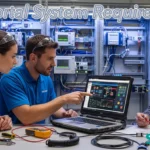If you’re planning to run Mastercam for CNC programming or precision manufacturing, getting the right hardware setup is just as important as mastering the software itself. A powerful computer doesn’t just make things faster — it makes the whole experience smoother, more reliable, and way less stressful.
Let’s go through everything you need to know about Mastercam system requirements — from the minimum specs to the dream setup that will make your CAM workflow fly.
TL;DR — Mastercam System Requirements
To run Mastercam smoothly, focus on CPU speed, RAM, and GPU quality.
- Minimum: Windows 10/11 Pro, 2.4 GHz CPU, 8–16 GB RAM, and a dedicated GPU with at least 1 GB VRAM.
- Recommended: Windows 11 Pro, Intel i7/i9 or AMD Ryzen 9 (3.2 GHz+), 32–64 GB RAM, and an NVIDIA RTX or AMD Radeon Pro GPU with 4–8 GB VRAM.
- Always use an SSD or NVMe drive for faster toolpath calculations and smooth 3D simulation.
💡 Bottom line: A fast CPU, plenty of RAM, and a pro-grade GPU make all the difference in Mastercam’s performance and reliability.
Also Read: Best laptops for Mastercam
Why Your System Specs Matter in Mastercam
Mastercam isn’t your average piece of software. It’s heavy on geometry processing, toolpath generation, and 3D visualization — which means your computer’s performance directly affects your productivity.
A sluggish CPU or weak graphics card can slow down toolpath calculations, crash during simulation, or make you wait for minutes that should’ve taken seconds. That’s why it’s smart to start with the right specs from day one.
Minimum System Requirements for Mastercam (2025)
If you’re just getting started or working with simple 2D or light 3D toolpaths, these specs will get you running without breaking the bank.
| Component | Minimum Requirements | Notes |
|---|---|---|
| Operating System | Windows 10 or 11 (64-bit, Professional Edition) | Home editions are not recommended |
| Processor (CPU) | Intel or AMD, 2.4 GHz or faster | Focus on strong single-core speed |
| Memory (RAM) | 8–16 GB | 8 GB bare minimum; 16 GB much smoother |
| Graphics Card (GPU) | Dedicated GPU with 1 GB+ VRAM, OpenGL 3.2 support | Avoid integrated graphics |
| Storage | 20 GB free space (SSD preferred) | SSDs improve performance significantly |
| Display | 1920×1080 resolution | Higher resolution optional |
| Extras | USB or network for license | Required for hardware or network license use |
✅ This setup works fine for learning, smaller parts, or 2.5D milling.
Recommended System Requirements for Mastercam Professionals
If you’re working on complex 3D models, multi-axis machining, or simulation-heavy jobs, here’s what you really want under the hood.
| Component | Recommended Specs | Why It Matters |
|---|---|---|
| Operating System | Windows 11 Pro (64-bit) | Latest, stable, and optimized for performance |
| Processor (CPU) | Intel Core i7/i9 or AMD Ryzen 9 (3.2 GHz+) | Strong single-core and multi-core speed |
| Memory (RAM) | 32–64 GB | Prevents lag in large toolpath calculations |
| Graphics Card (GPU) | NVIDIA RTX / Quadro or AMD Radeon Pro, 4–8 GB VRAM | Certified for CAD/CAM, stable OpenGL drivers |
| Storage | NVMe SSD | Super-fast loading and saving times |
| Monitors | Dual 1080p or 1440p screens | Improves workflow and toolpath visualization |
| Peripherals | 3Dconnexion 3D mouse | Optional, but speeds up design navigation |
💡 This is the sweet spot for professionals who want reliability, speed, and smooth visuals without interruptions.
Performance Tips That Actually Make a Difference
Here are a few practical ways to make Mastercam run better on any system:
- Prioritize CPU Speed Over Core Count
Mastercam loves fast single-thread performance. A 5 GHz single-core chip often outperforms a slower multi-core CPU for most toolpath operations. - Use a Professional GPU with Stable Drivers
Certified GPUs like NVIDIA Quadro or RTX A-series are more reliable for OpenGL rendering and reduce display glitches. - Keep Your SSD Clean
Leave at least 20–30% free space on your SSD for temp files and simulations. It can make a noticeable difference in performance. - Avoid Running Mastercam on Virtual Machines
It’s not officially supported and can cause unpredictable lag or licensing issues. - Regularly Update Drivers and Windows
Updated graphics and chipset drivers can fix display bugs and improve stability.
Quick Comparison: Minimum vs. Recommended Setup
| Feature | Minimum | Recommended |
|---|---|---|
| CPU | 2.4 GHz | 3.2 GHz+ i7/i9 |
| RAM | 8–16 GB | 32–64 GB |
| GPU | 1 GB VRAM | 4–8 GB VRAM |
| Storage | HDD / basic SSD | NVMe SSD |
| OS | Windows 10 Pro | Windows 11 Pro |
Final Thoughts: Build Smart, Work Fast
If you’re serious about precision engineering or CNC programming, investing in a solid workstation for Mastercam isn’t a luxury — it’s a productivity boost. Whether you’re designing molds, programming 5-axis paths, or running full simulations, your hardware decides how much time you spend waiting versus creating.
Choose wisely, keep your drivers up to date, and you’ll notice the difference in every toolpath you generate.
Bonus Tip
If you’re comparing laptops or workstations for CAD/CAM software, check out Engineering Laptops — it’s packed with real, honest laptop guides made for engineers, designers, and machinists who actually use tools like Mastercam, SolidWorks, and Fusion 360 every day.
FAQs
Mastercam runs best on Windows 10 or 11 (64-bit Professional edition). You’ll want at least an Intel or AMD processor with solid single-core performance, 16 GB of RAM or more, and a dedicated graphics card that supports OpenGL. For smoother performance and faster toolpath calculations, go for 32 GB of RAM, an SSD or NVMe drive, and a workstation-class GPU such as an NVIDIA RTX or AMD Radeon Pro.
You can technically run Mastercam with 8 GB of RAM, but that’s really the bare minimum. If you’re working with complex parts, 3D models, or large toolpaths, 32 GB is the practical choice. Many professionals even go for 64 GB just to keep things fluid during simulation or multitasking.
A great Mastercam laptop has a strong CPU, a professional GPU, and fast storage. Models with Intel Core i7 or i9 processors, NVIDIA RTX or Quadro graphics, and at least 32 GB of RAM tend to handle Mastercam beautifully. If you’re looking for trusted recommendations, check EngineeringLaptops.com — they review laptops specifically for CAD/CAM and engineering software.
Mastercam relies heavily on single-core speed for most toolpath calculations. That means a processor like Intel’s Core i7 or i9 (with boost speeds above 5 GHz) or AMD’s Ryzen 9 series will give you excellent results. It’s better to choose a CPU with higher clock speed than one with more cores but lower single-thread performance.
How to make sure your computer is ready for Mastercam
Time needed: 10 minutes
Learn how to make sure your computer is ready for Mastercam 2025. This quick three-step guide will help you check your hardware, adjust your setup, and get smooth performance right from the start.
- Check Your Operating System and Processor
Make sure you’re running Windows 10 or 11 (64-bit, Professional edition). Then confirm your CPU: ideally an Intel Core i7/i9 or AMD Ryzen 9 with strong single-core speed (3.2 GHz or higher). This ensures toolpaths generate quickly and Mastercam runs reliably.
- Verify Your RAM and Graphics Card
Open your system settings and check your memory (RAM). You’ll want at least 16 GB, but 32–64 GB is ideal for larger 3D models.
Next, confirm that you have a dedicated GPU — such as an NVIDIA RTX/Quadro or AMD Radeon Pro with 4 GB or more VRAM. Avoid integrated graphics for best results. - Optimize Storage and Drivers
Use an SSD or NVMe drive for Mastercam installation and project files. Keep at least 20 GB of free space available. Finally, update your graphics and chipset drivers to the latest stable versions to prevent lag, display glitches, or crashes during toolpath simulation.










